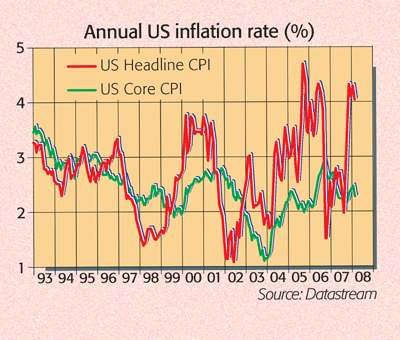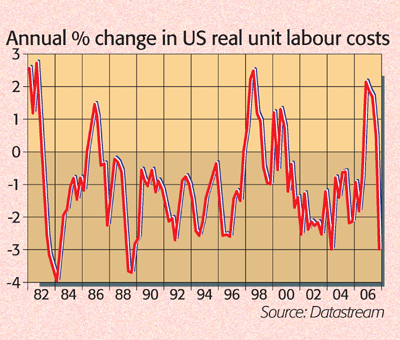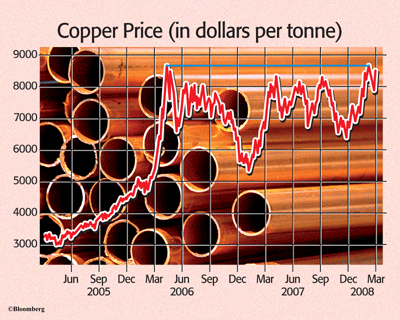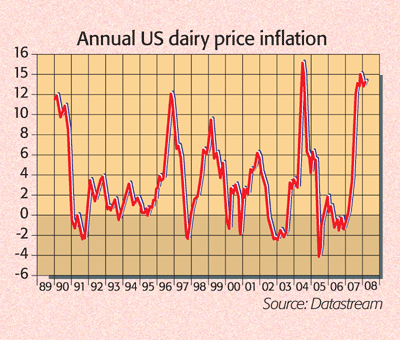Why it’s time to take profits on commodities
Fund managers see inflation as a real threat, but with America in – or heading for – recession, we should be more worried about deflation as consumer demand collapses. And that’s bad news for commodities, says James Ferguson.
Fund managers believe inflation is still a real threat, but with America in or heading for recession, we should be more worried about deflation as consumer demand collapses. And that's bad news for the commodities boom, says James Ferguson
According to the latest Merrill Lynch survey, most fund managers expect above-average prices this year with below-average economic growth. In other words, a return to that horror of the early 1980s: stagflation. These people see rising commodity prices feeding directly into the corporate sector's input costs (as measured by the producer price index, or PPI), which, exacerbated by the falling dollar, is pumping up headline consumer price index (CPI) inflation. Throw in imminent recession and that almost guarantees stagflation.
At first, it seems they could be right. The US economy is undoubtedly slowing, yet PPI inflation rose to +7.7% in January and is now at its highest level since 1981. This has pushed headline CPI inflation as high as 4.3% and could yet send it above 4.5%. But two very important things are set to prevent this rise in raw material costs from leading to self-sustaining, core inflation. I want to explain why the inflation part of this argument is just plain wrong and why this means that commodities are heading for a fall.
MoneyWeek
Subscribe to MoneyWeek today and get your first six magazine issues absolutely FREE

Sign up to Money Morning
Don't miss the latest investment and personal finances news, market analysis, plus money-saving tips with our free twice-daily newsletter
Don't miss the latest investment and personal finances news, market analysis, plus money-saving tips with our free twice-daily newsletter
Look first at the Federal Reserve's preferred measure of inflation, core CPI, which excludes food and energy (the green line on the chart below). By this measure, inflation is running at a rather benign 2.3%. So why is this the Fed's preferred way of looking at inflation?

The answer is that some price rises act like cost increases. These external (or exogenous, as economists insist on calling them) price rises operate like tax hikes, especially if they affect essentials (like food and energy). This sort of inflation forces people to make sacrifices elsewhere and slows economic demand for other goods, as buyers substitute cheaper products for their previous purchases where possible. This is what we face today. Ironically, this sort of "inflation" is really quite deflationary. In other words, it doesn't last long (farmers plant more crops, oil users go on an efficiency drive), but it has the delayed effect of slowing the economy.
Endogenous, or internally generated, inflation is different. It is embedded in the economy and especially in the wage bargaining round. Each price rise is met by a more than equal and opposite wage hike, which leads to spiralling unit labour costs, squeezing firms' profit margins and forcing them to pass on higher prices, kicking the whole thing off again. This is what we don't have. Indeed, inflation expectations in the US and euro area have basically been flat for several years.
The other key point is that, for most first-world firms, labour costs account for a far higher proportion of total input costs than commodities do. And staffing costs aren't going up. In fact, real unit labour costs are running at a negative rate (see the second chart below) and have pretty much always been below CPI since the early 1980s the era of stagflation. The current situation looks nothing like the early 1980s.

Ask any American worker. The US consumer, already without any visible bargaining power over wages, is facing external cost rises in energy and food prices, sapping his disposable income. Unable to demand higher wages because of global labour deflation; unwilling to strike because of rising unemployment; and wanting to save more now his house is losing value (the savings ratio has already fallen from 12% of income in 1982 to zero today), the US consumer has only one alternative to cut back on discretionary expenditure.
This is not a recipe for stagflation, which requires labour to be disproportionately empowered at the expense of capital, but instead is the harbinger of a deflationary demand recession. As consumers stop spending, firms will find inventory building up. Because falling real unit labour costs have been pushing profit margins up faster than rising input costs are pushing them down, they will be able to discount prices to clear the log jam without unduly hurting profit margins. That means lower, not higher, prices.
A credit crunch pushing up borrowing costs, a lack of demand, substitution, an increase in precautionary savings and inventory fire-sales. Dust your economics 101 primer off and look it up. It's a deflationary recession, pure and simple. And if demand for goods falls, that'll hit demand for the materials that make them too. That's bad news for commodities.
Has the correction already started?
It was always a stretch of almost heroic proportions, in my book, to believe that the Asian exporting economies (those running trade surpluses) could decouple from the US, which accounts for more than 20% of global consumption and has the biggest trade deficit the world has ever seen.
Asian stockmarket investors have already realised it's a bit daft to expect to come out of a US recession unscathed. According to the Merrill Lynch survey, 95% of regionally-based fund managers now expect Chinese real economic growth to slow. The Pacific Rim diversified manufacturing, iron and steel, machinery and machine tool sectors have all dropped by nearly a third.
The growth scare has gone global. Well, nearly global. The commodity space has remained blissfully untroubled by a demand slowdown that has been dominating the bond markets for nine months, disturbing equities for almost as long, and since at least the New Year, has been upsetting emerging markets too.
This partly explains the stagflation' call. What do you have if capital markets indicate an economic slowdown and commodity market prices imply massive supply shortages? If you believe in perfectly efficient markets without lags, then the message is clear: stagflation.
But what if markets aren't efficient? Or if they are efficient but with lags? What if they're not efficient all the time, just on average (which is actually all the original hypothesis claimed anyway)? In that case you may think that the combined weight of the global bond and equity markets was telling you something. And at last, the message seems to be getting through to commodity markets. A fortnight ago, without any warning, the oil-heavy CRB commodity index dropped 11% before making a partial recovery. King' copper, so-called because it is the main economically sensitive metal, dropped nearly 14%, after hitting a big double-top (a technical signal to sell see the blue line on the chart below).

Gold fell 12% and has hardly recovered at all. Silver plummeted 22% and has also made barely any recovery. And several industrial metals long-since gave up any vestiges of being in a bull trend. Zinc has been in a downtrend for 18 months now, nickel prices peaked last summer and lead last hit a new high back in October. Aluminium has also reached what could be a multi-year double top.
The whole industrial metals story is based on supply shortages. But that in turn is based on the idea that demand remains robust, especially from China. But if everything else we're seeing is telling us that demand is weakening, including demand from China's trading partners, then the demand/supply imbalance already looks a little less precarious, knocking away a vital driver of the boom in base metals.
But what of agricultural commodities? Surely nothing can stop their inexorable rise? Years of falling prices and open trade have not only led to continents such as Africa substituting rice for home-grown millet, but more insidiously have seen stockpiles run down because of the limited attraction of holding inventory whose value kept declining. Stockpiles used to equal 35% of production but that has fallen now to 15%, equal to 50 days of supply making the system very vulnerable to weather-related shortages.
Rice, the staple food for almost half the world's population, has doubled in price over the last year. With low stocks and fears of hoarding, several producers, including China, Vietnam, India and Egypt, have curbed exports. In Bangladesh a strange quirk of economics, called a Giffen good' has reared its ugly head again. This is where demand for an inferior staple (in this case rice) actually goes up as its price rises, because there is insufficient disposable income left over for luxuries such as meat.
But I think we're worrying unnecessarily about commodity food inflation. The first reason is that price, in a reasonably free market at least, is a demand discovery indicator. It should be no surprise to anyone that demand for food is strong, ability to pay is (mainly) strong and warehouse stocks are low, so prices have risen. All well and good.
Now I ask you, will more or less rice get planted this year? Basic economics suggests that all sorts of marginal land and marginal players will return to rice farming to join the gold-rush. It may take more than 12 months to build up bigger reserves but, weather depending, it shouldn't take all that long. In the meantime, most rice buyers where possible will substitute rice for something else, learn to use it less wastefully, or otherwise adjust their demand. At the very least, many of the quibbles over GM seeds will be quietly forgotten if they promise a richer harvest, or a more resilient one from marginal land.
And remember that the farming cycle comes around much more frequently than the economic one. You'd think this was the first time there'd been a bit of food-price inflation in living memory to hear some people talk. In fact, US dairy product prices seem to have been in a three-year cycle since 1995 (see the chart below) and food-price cycles have a habit of reversing just as quickly as your average farmer can plant next year's seedlings.

The weak dollar is one further reason behind the rise in commodity prices; but that only accounts for about 15% of the move over the last year. Beyond that there have been a lot of long-term structural supply shortage concerns and a fair amount of pure speculation on top of that. But as I've already pointed out, with much weaker global demand on the horizon and bond markets even warning of recession, supply shortages could quickly become demand shortages. As supply shortages fade, the threat of inflation will fade too.
What that means for the commodity bull market is that suddenly the emperor will appear to be wearing very little finery indeed. Emerging markets have woken up to this fact and the big wobble that the CRB index had a fortnight ago will probably be seen with hindsight as the warning shot across the bows for the commodity bull run.
Now long-term, commodities do appear to be in the midst of a multi-year catch-up with other asset classes, as Tim Price points out below. But from a shorter-term, cyclical point-of-view, the macro-economic environment now is all about demand downturn, credit constraints and unless we're lucky, outright recession. That is not a commodity-friendly backdrop. Most at risk are probably mining shares because they are a pure play on industrial metal and coal prices (which are directly linked to steel and infrastructure demand), so it's time to take profits on your miners.
Agricultural plays such as farm machinery and GM stocks will continue to benefit for now; although the food cycle is not long by economic terms, it is very strong based on genuine shortages and precautionary stock piles will need to be rebuilt. MoneyWeek's position on gold is still positive (see Tim's comments below), but I think it looks very overbought. If the other commodity metals hit the buffers, I can't see gold bucking the trend, especially in light of silver's recent scarily big drop.
Oil is trickier because it's less overbought (would you believe), but in any case the way to play oil for me is still via the greatly underrated and under-performing oil majors, such as BP (BP) and Shell (RDSB), which are cheap, liquid and high yielding, with strong balance sheets. To my mind these stocks are discounting an oil price way below current levels, so they remain a buy.
James Ferguson is an economist and stockbroker with Pali International. He also edits the Model Investor newsletter.
But the long-term outlook for commodities is still bullish
Commodities have a long history of being one of the most volatile asset classes, writes Tim Price.
In the summer of 2006, for example, nickel prices rose by almost 50% in less than a month, while in agricultural commodities, price volatility is magnified by the impact of weather and harvests.
But price swings have lately been extended by the greater role played by the leveraged community and by the rise of exchange-traded funds (ETFs), which have offered retail investors the chance to trade in these markets without getting involved in derivatives or taking physical delivery of things like wheat, pork bellies or oil.
My suspicion is that commodities have recently enjoyed huge popularity for three specific reasons. One is momentum-trading by the likes of hedge funds, happy to ride a rising price chart, and equally happy to reverse course once prices fall, adding to volatility in both directions.
Another is down to investors becoming concerned at the weakness of the US dollar and the global financial system, driving them to buy "stuff" rather than financial assets, either as a hedge, or as an outright investment. This surely lies behind the huge rise in the prices of gold, silver, platinum and palladium, as "alternative money" at a time when bank deposits look less than gilt-edged.
The third, perhaps most compelling reason, is that institutional investors are looking to diversify their portfolios by raising exposure to commodities. Modern portfolio theory holds that a variety of less correlated assets has a good chance of beating just one type of investment, with reduced risk. The portfolios of US university endowments such as Yale's have delivered stunning results from, in part, having substantial commitments to commodities and natural resources in recent years. This reweighting probably has some way to go. Bloomberg reported in early March that the Calpers pension fund, the largest in the US, was considering raising its commodities investments some 16-fold, for example.
It seems likely that a broken US financial system will drag America, and much of the world, into recession this year. That bodes ill in the short term for economically-sensitive industrial metals. But until the economic system (and US property market) recovers, it seems reasonable to expect that precious metals will continue to benefit from safe-haven flows. Any further weakness in gold should probably be seen as a buying opportunity. And as long as the rise of China and India is a valid theme, commodities in general seem poised to benefit from years of unprecedented demand.
It may be a crowded trade, but I am keeping faith with the commodities story. At a time of equally unprecedented threat to financial sector stability, portfolio diversification demands it.
Tim Price is director of Investment at PFP Group.
Get the latest financial news, insights and expert analysis from our award-winning MoneyWeek team, to help you understand what really matters when it comes to your finances.
James Ferguson qualified with an MA (Hons) in economics from Edinburgh University in 1985. For the last 21 years he has had a high-powered career in institutional stock broking, specialising in equities, working for Nomura, Robert Fleming, SBC Warburg, Dresdner Kleinwort Wasserstein and Mitsubishi Securities.

